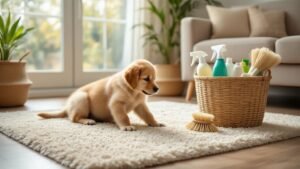Imagine coming home to find your beloved pet has had an accident on your pristine carpet. As a pet owner, this is a common scenario that can be quite daunting to handle. However, with the right mix of patience, knowledge, and tools, you can master the art of DIY carpet cleaning.
Cleaning up after accidents is just one aspect of carpet care for pet owners. It's also important to focus on preventive measures and maintaining a clean and fresh environment for both you and your furry friends. By incorporating these essential tips into your routine, you can ensure that your carpets remain spotless and odor-free.
One important tip is to create homemade cleaning solutions that are safe for pets. This way, you can avoid using harsh chemicals that may be harmful to your pets. For example, a simple mixture of white vinegar and water can be effective in removing stains and odors. Additionally, baking soda can be sprinkled on the carpet before vacuuming to absorb any unwanted smells.
Dealing with pet hair can also be a challenge. Regular vacuuming is essential to remove loose hair and prevent it from embedding into the carpet fibers. Using a vacuum cleaner with a pet hair attachment or a specialized pet hair remover can make this task even easier. It's also a good idea to groom your pets regularly to minimize shedding.
Furthermore, addressing pet odors is crucial for a fresh-smelling home. Along with regular cleaning, you can use odor-neutralizing products specifically designed for pet odors. These products often contain enzymes that break down the odor-causing molecules, leaving your carpets smelling clean and fresh.
In addition to cleaning up accidents, preventive measures can go a long way in maintaining a clean carpet. Consider using pet-friendly rugs or mats in high-traffic areas to protect your carpet from stains and wear. It's also a good idea to train your pets to use designated areas for elimination, such as litter boxes or potty pads.
When it comes to maintaining a clean carpet, consistency is key. Establish a regular cleaning routine that includes vacuuming, spot cleaning, and deep cleaning as needed. By staying on top of these tasks, you can prevent stains and odors from becoming deeply embedded in the carpet fibers.
In summary, mastering the art of DIY carpet cleaning as a pet owner requires a combination of preventive care, proper cleaning techniques, and the right tools. By incorporating these essential tips into your routine, you can keep your carpets clean, fresh, and free from pet-related issues. So roll up your sleeves and get ready to tackle any carpet challenge with ease, creating a harmonious living space for both you and your furry friends.
Understanding Carpet Challenges
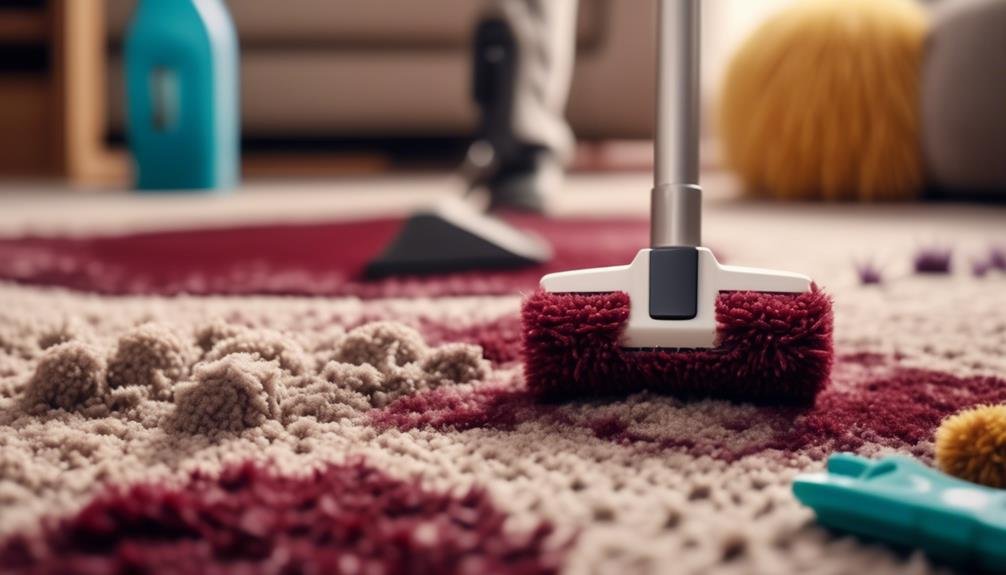
As a pet owner, you're probably familiar with the unique challenges that come with having fur babies. Dealing with fur, dander, and unexpected accidents can make it difficult to keep your carpets clean. It's not just about the everyday shedding; it's those moments when your beloved pet decides to use your living room carpet as a bathroom or tracks mud from their outdoor adventures. These incidents can test your patience and love for your furry friend, but understanding the obstacles you face can make a world of difference.
Let's start with pet fur. It's not just an eyesore; it can actually embed itself deep into the fibers of your carpet, making it a real challenge to remove without the right tools. And then there's dander – those tiny flakes of skin that pets shed. Dander can work its way into your carpets, contributing to allergies and making it feel like a clean, fresh-smelling home is an impossible dream. And let's not forget about those accidents – urine, feces, and vomit can leave behind stubborn stains and odors that seem impossible to get rid of.
Armed with this knowledge, you can now take on these challenges with confidence. It's not just about cleaning more frequently; it's about cleaning smartly.
To simplify things, use clear and straightforward language. Avoid using cliches and overused words. Instead of just stating facts, provide context and explain why something is important. Use transitions thoughtfully to create a natural flow in your writing. Choose active voice over passive voice to enhance clarity. Feel free to include specific examples and product recommendations as needed. And of course, correct any spelling and grammar errors.
Homemade Cleaning Solutions
When it comes to dealing with pet fur, dander, and accidents, it's a good idea to consider homemade cleaning solutions that are both effective and safe for your furry family members. These DIY concoctions can help you keep your carpets clean without using harsh chemicals that could potentially harm your pets or the environment.
By making your own cleaning solutions, you have control over the ingredients, ensuring that they're pet-friendly and effective for the specific stains and odors left behind by your pets. Here are a few simple recipes to get you started:
- Vinegar and Water Mixture: This mixture is ideal for general cleaning and deodorizing. Simply mix equal parts of white vinegar and water and use it to clean your carpets.
- Baking Soda and Vinegar Paste: If you're dealing with tougher stains, creating a paste with baking soda and a small amount of vinegar can be effective. Apply the paste to the stain, let it sit for a while, and then scrub it away.
- Hydrogen Peroxide and Dish Soap: For old or tough stains, a mixture of a teaspoon of dish soap and a cup of hydrogen peroxide can work wonders. Apply the mixture to the stain, let it sit for a few minutes, and then blot it away.
- Lemon and Water Solution: If you simply want to freshen up your carpets, a mixture of the juice of one lemon and two cups of water can do the trick. Spray or sprinkle the solution on your carpets and let it air dry.
These homemade cleaning solutions aren't only effective, but they're also safe for your pets and the environment. Plus, they're easy to make with ingredients you likely already have at home. So give them a try and enjoy clean and fresh carpets without worrying about any potential harm to your furry friends.
Techniques for Pet Hair
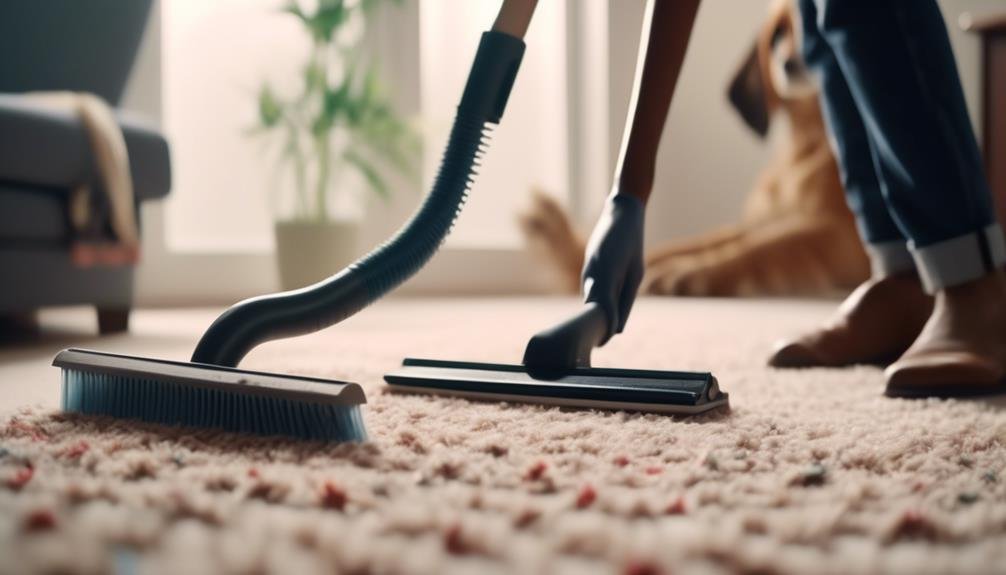
If you're a pet owner, you know the struggle of dealing with pet hair in your carpets. It's not just about how it looks; it can also impact the cleanliness of your home and even the air quality. But don't worry, there are ways to effectively remove pet hair from your carpets.
First and foremost, invest in a high-quality vacuum cleaner that's specifically designed for pet hair. Regular vacuuming is essential, so make sure to do it at least twice a week. However, even the best vacuum might miss some stubborn pet hair. In those cases, you can use a rubber squeegee or a dampened sponge. The rubber edge of the squeegee can catch and pull out the hair that the vacuum didn't pick up.
Another effective technique is to use a stiff-bristled brush. Gently but firmly brush the carpet in one direction. This will gather the hair into clumps, making it easier to pick up or vacuum away.
Prevention is also key. Regularly grooming your pets can significantly reduce the amount of hair that ends up on your carpets. Plus, it's a great way to bond with your furry friends.
Common Pet Stain Solutions
Dealing with pet stains on your carpets can be a frustrating task, but it's a challenge that many pet owners face. Fortunately, there are effective solutions that can help you tackle these stains with confidence. Let's explore some common pet stain issues and how to address them:
One simple and effective solution is a vinegar and water mixture. By combining equal parts water and vinegar, you can break down most pet stains. Simply apply the solution to the stain, let it sit for a few minutes, and then blot it dry. This method is gentle yet powerful in removing stains.
For odors associated with pet stains, baking soda is your best friend. After cleaning the stain, sprinkle some baking soda over the area. If possible, leave it overnight to absorb the odors, and then vacuum it up the next day. Baking soda is excellent at neutralizing unpleasant smells.
In cases of tougher stains, a solution of water and hydrogen peroxide (3%) can be highly effective. However, it's crucial to test this solution on an inconspicuous area of your carpet first to ensure it doesn't cause any discoloration. Hydrogen peroxide can be a powerful stain remover, but caution is key.
When it comes to pet stains, enzymatic cleaners are a must-have for any pet owner. These cleaners are specially formulated to break down pet waste and eliminate odors at a molecular level. They're designed to target the specific components of pet stains, ensuring a thorough and effective cleaning.
Remember, when using any cleaning solution, it's essential to follow the instructions carefully and to blot the stain rather than rub it. Rubbing can spread the stain and damage your carpet fibers. Additionally, always test any cleaner on a small, inconspicuous area of your carpet before applying it to a larger stain.
With these effective solutions and a little patience, you can confidently tackle common pet stains on your carpets. Don't let those unsightly marks discourage you; instead, take action and restore your carpets to their former glory.
Managing Pet Odors
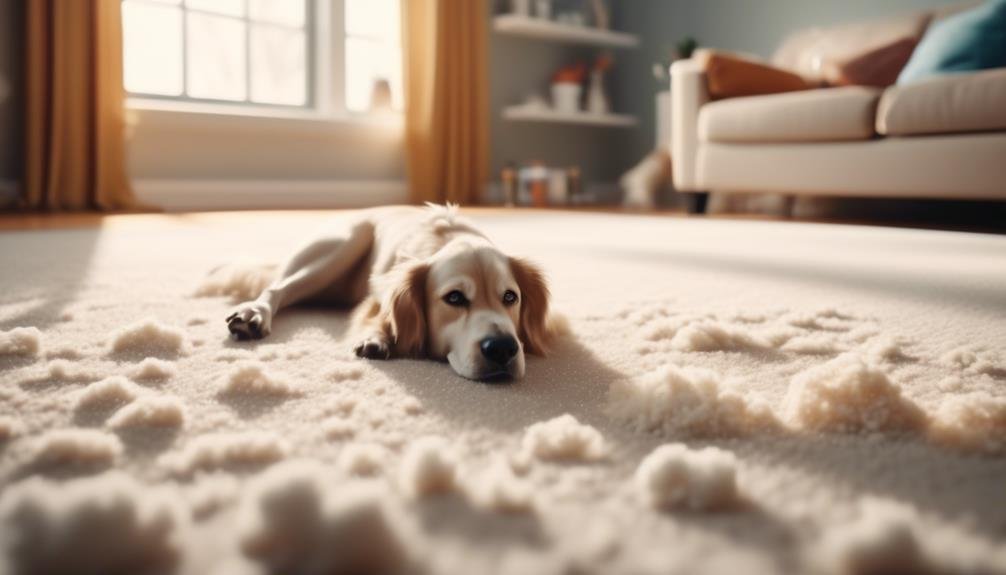
Dealing with pet odors in your home can be a challenge, but with the right approach, you can keep your living space fresh and welcoming. It's not just about cleanliness; it's about creating an environment where both you and your pets can thrive without worrying about unwanted smells.
To effectively tackle pet odors, follow these practical steps:
- Identify the source of the odor: When you notice a pet odor, take the time to locate its source. It could be a soiled spot on the carpet, a pet bed that needs washing, or even the litter box. By pinpointing the source, you can address it directly.
- Use enzymatic cleaners: Enzymatic cleaners are highly effective in eliminating pet odors. These cleaners break down the odor-causing molecules at a molecular level, ensuring that the smell is completely eradicated. Look for enzymatic cleaners specifically designed for pet odors for the best results.
- Regularly ventilate your home: Proper ventilation is key to keeping your home smelling fresh. Open windows and doors to allow fresh air to circulate and remove any lingering odors. Consider using fans or air purifiers to improve air circulation and reduce pet odors.
- Apply baking soda on carpets overnight: Baking soda is a natural deodorizer that can help absorb and neutralize pet odors. Sprinkle baking soda liberally over your carpets, let it sit overnight, and then vacuum it up in the morning. This simple step can significantly reduce pet odors in your home.
- Invest in a high-quality air purifier: An air purifier can be a game-changer when it comes to eliminating pet odors. Look for a purifier with a HEPA filter, as it can effectively capture pet dander, hair, and other allergens that contribute to odors. Additionally, some air purifiers come with specific pet odor filters or features that target and neutralize pet smells.
Regular Carpet Care
Regular Carpet Care
To keep your carpet fresh and extend its lifespan, it's important to regularly care for it, especially if you have pets. Our furry friends, as much as we love them, can be tough on our floors. From muddy paws to shedding and even the occasional accident, staying on top of cleaning is essential to prevent permanent damage or lingering odors.
We understand that life gets busy and dealing with pet messes can be overwhelming. That's why we've put together four key strategies to integrate into your routine, ensuring your carpets stay clean and your home remains welcoming:
- Vacuum regularly: Aim to vacuum at least twice a week to effectively remove pet hair and dander. This will help keep your carpet looking fresh and prevent allergens from building up.
- Spot clean spills immediately: We all know that accidents happen, but the longer a stain sits, the harder it becomes to remove. Be sure to address spills promptly by blotting the area with a clean cloth and using a mild carpet cleaner if necessary.
- Invest in a high-quality carpet cleaner: For a deep clean and effective management of pet odors, investing in a reliable carpet cleaner is invaluable. Look for one specifically designed to tackle pet messes and consider models with features like upholstery attachments for added versatility.
- Keep your pets groomed: Regular baths and brushings not only keep your pets looking their best, but they also help reduce the amount of hair and dirt they track into your home. This can significantly minimize the amount of dirt and debris that ends up in your carpet.
Vacuuming Pet Hair
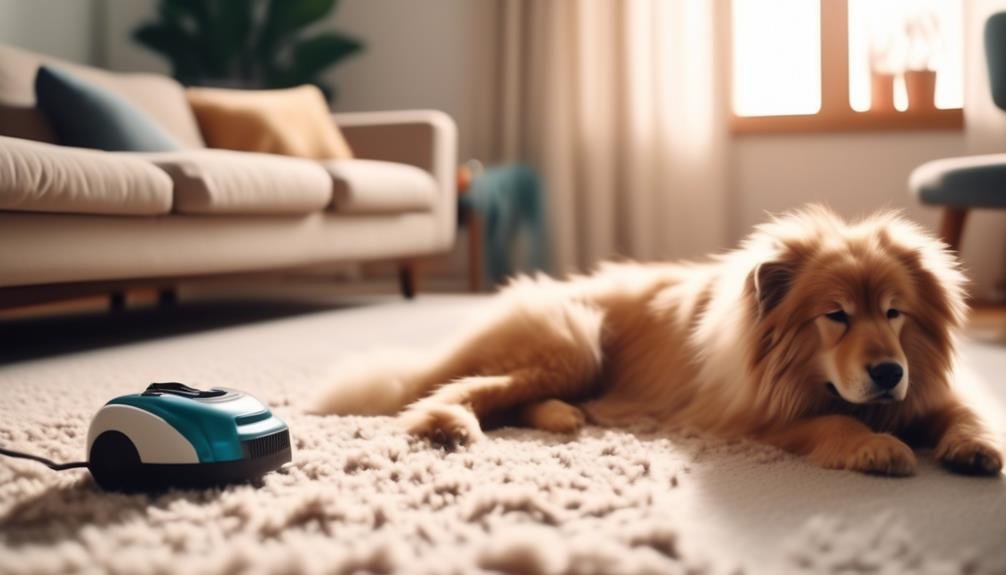
When it comes to dealing with pet hair, vacuuming is your best defense to keep your carpets clean and free of allergens. It's important to choose a vacuum specifically designed to handle pet hair, as regular models may not be effective enough. To get the most out of your vacuuming routine, make sure you're using the right attachments and settings to effectively pick up pet hair without causing any damage to your carpets. Here's a quick guide to help you navigate the vacuuming process more effectively.
One important feature to look for in a pet hair vacuum is upholstery attachments. These attachments allow you to target clean furniture and hard-to-reach areas where pet hair tends to accumulate. This ensures that you can thoroughly clean every nook and cranny of your home.
Another useful feature is adjustable suction. This allows you to customize the suction power of your vacuum to match the different carpet piles in your home. By using the right suction level, you can effectively clean your carpets without causing any damage.
HEPA filters are another crucial feature to consider when choosing a pet hair vacuum. These filters are designed to trap allergens, such as pet dander, making your home a healthier environment for everyone, especially those with allergies or asthma.
A brush roll is another essential component of a pet hair vacuum. This feature agitates the carpet fibers, loosening and lifting pet hair for easier removal. It helps ensure that even the most stubborn pet hair is effectively picked up by the vacuum.
If you're looking for convenience and ease of use, a cordless vacuum is a great option. With a cordless design, you can easily maneuver around your home without being restricted by a power cord. This ensures that no spot is left uncleaned and makes the vacuuming process much more efficient.
Spot Cleaning Tips
Spot cleaning is an essential step in keeping your home clean and fresh, especially if you have pets. It's important to address these spots promptly to prevent them from becoming more difficult to remove. Here are some tips to effectively tackle stubborn stains:
First, identify the type of stain you're dealing with. Different messes require different solutions. For example, urine stains may require an enzymatic cleaner to break down the odor and stain molecules, while mud stains can often be removed with gentle soap and water.
Before applying any cleaning solution, it's crucial to test it on an inconspicuous area of your carpet to ensure it won't cause any damage. This step is especially important if you're using a new product or homemade solution.
When it comes to actually cleaning the spot, remember to blot the area instead of rubbing it. Blotting helps prevent the stain from spreading further. Additionally, using cold water instead of hot water can help prevent the stain from setting in.
Instead of soaking the entire area, apply a small amount of cleaner directly to the stain. This targeted approach helps minimize the risk of over-wetting the carpet.
Be patient when treating stains. Some stains may require multiple treatments before they're completely removed. It's important to follow the instructions on the cleaning product and give it enough time to work its magic.
Carpet Cleaning Schedule
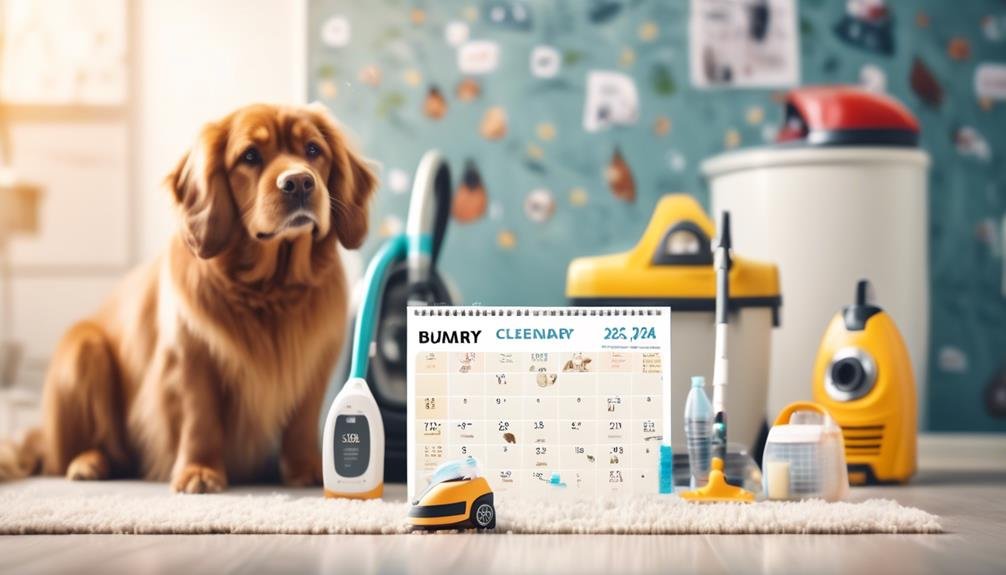
Having a regular carpet cleaning schedule is essential for pet owners who want to maintain a clean and healthy living environment. Pets can track in dirt and leave behind dander and odors, so it's important to have a plan in place to keep your carpets fresh.
To start, it's a good idea to vacuum your carpets lightly at least twice a week. This will help to pick up pet hair and loose dirt before it has a chance to settle deep into the carpet fibers. If you have a busy household or a particularly furry pet, you may want to consider vacuuming daily in high-traffic areas to stay on top of the dirt.
In addition to regular vacuuming, it's important to incorporate a thorough vacuuming into your routine every two weeks. Use attachments to reach under furniture and along edges where pet hair tends to accumulate. This is also a great opportunity to check for any spots that may need extra attention and address them promptly.
Finally, it's recommended to commit to a deep clean every three to six months. This can be done by renting a carpet cleaning machine or hiring a professional service. A deep clean will help to remove embedded dirt and odors, refreshing your entire home and ensuring a clean and healthy environment for both you and your pets.
Frequently Asked Questions
How Can I Safely Clean Carpets if My Pet Has Allergies or Sensitivities to Certain Cleaning Products?
If your pet has allergies or sensitivities to certain cleaning products, it's important to choose natural and hypoallergenic solutions to clean your carpets. Baking soda and vinegar are excellent options to start with. These ingredients are gentle and unlikely to cause any adverse reactions in your pet.
Before applying any cleaning solution to your carpet, it's crucial to do a patch test in an inconspicuous area. This will help you determine if your pet will have any negative reactions to the cleaning solution.
When cleaning your carpets, it's also important to keep your pet away until the carpet is fully dry. This will help prevent any potential reactions or discomfort for your furry friend.
In addition to baking soda and vinegar, there are other natural carpet cleaning solutions available in the market. Look for products that are specifically formulated for pets with allergies or sensitivities. These products often contain plant-based ingredients that are safe for both your pet and the environment.
Remember to always follow the instructions provided by the manufacturer when using any cleaning product. This will ensure that you use the product correctly and effectively.
What Are the Best Practices for Drying Carpets Quickly After a Deep Clean to Prevent Mold, Especially in Humid Climates?
To dry carpets quickly after a deep clean and prevent mold, especially in humid climates, it's important to follow some best practices. Think of the carpet as a thirsty sponge in the sun, and use the following methods to efficiently circulate air:
- Use fans: Place fans strategically around the carpeted area to increase airflow. This will help speed up the drying process. If possible, use both ceiling fans and portable fans to create a cross breeze.
- Open windows: If the weather permits, open windows to let fresh air in and allow moisture to escape. This will help reduce the overall humidity in the room and aid in drying the carpet faster.
- Dehumidifier: Consider using a dehumidifier to remove excess moisture from the air. This will not only help in drying the carpet but also prevent the growth of mold and mildew.
By combining these methods, you can create an ideal environment for quick carpet drying. However, it's important to note that these practices may not be sufficient for extremely wet carpets or in cases of severe water damage. In such situations, it is recommended to seek professional help.
For added convenience and effectiveness, you can also consider using specialized carpet drying equipment. One such recommendation is the B-Air Grizzly Air Mover, which is designed specifically for drying carpets and has a powerful airflow to speed up the drying process.
Are There Any Eco-Friendly or Sustainable Carpet Cleaning Methods That Are Safe for Pets and Effective for Pet-Related Messes?
Yes, there are several eco-friendly carpet cleaning methods that are safe for pets and effective for pet-related messes. Instead of using harsh chemicals, you can opt for homemade cleaners made with natural ingredients such as vinegar, baking soda, or essential oils.
Vinegar is a great option for removing pet stains and odors. Simply mix equal parts of white vinegar and water, and apply it to the stained area. Let it sit for a few minutes, then blot it with a clean cloth. Vinegar not only helps to remove stains but also neutralizes odors.
Baking soda is another eco-friendly ingredient that works well for cleaning carpets. Sprinkle baking soda liberally over the stained area and let it sit for a few hours or overnight. Then, vacuum the area to remove the baking soda along with the stain. Baking soda is known for its odor-absorbing properties and can help eliminate pet smells from your carpet.
Essential oils can also be used to create a pet-friendly carpet cleaner. Mix a few drops of your favorite essential oil, such as lavender or tea tree oil, with water in a spray bottle. Spray the mixture onto the stained area and let it sit for a few minutes. Then, blot it with a clean cloth. Not only will this method help remove stains, but it will also leave a pleasant scent in your home.
In addition to these homemade cleaners, there are also eco-friendly carpet cleaning products available in the market. Look for products that are labeled as pet-friendly and biodegradable. These products are specifically designed to be safe for pets and the environment while effectively tackling pet stains and odors.
When using any carpet cleaning method, it's important to test it on a small, inconspicuous area first to ensure it doesn't cause any damage or discoloration. Additionally, always follow the instructions provided with the cleaning products or consult a professional carpet cleaner for advice.
How Can I Remove Pet Hair From Upholstery and Other Soft Furnishings in Conjunction With Carpet Cleaning for a Holistic Clean?
When it comes to removing pet hair from upholstery and other soft furnishings, it's important to approach it with patience and the right tools. Think of it like weeding a garden – a journey towards a hair-free home. Here are some tips to help you along the way.
Firstly, you'll need a good vacuum cleaner with attachments specifically designed for upholstery. These attachments typically have brush bristles that can effectively loosen and remove pet hair from fabric. Make sure to use a vacuum with strong suction power to ensure thorough cleaning.
Another handy tool to have is a lint roller. Lint rollers are sticky and can easily pick up pet hair from upholstery. Simply roll the lint roller over the fabric, and the sticky surface will grab the hair and remove it. This method is especially effective for smaller areas or when dealing with more stubborn pet hair.
In addition to these tools, it's also helpful to establish a regular cleaning routine. By vacuuming and using a lint roller on your upholstery and soft furnishings regularly, you can prevent a buildup of pet hair and keep your home looking clean and fresh.
When it comes to carpet cleaning, you can incorporate pet hair removal into your routine. Start by vacuuming the carpet thoroughly to remove loose pet hair. Then, use a carpet cleaner or spot cleaner specifically formulated for pet stains and odors. These products often have enzymes that break down pet hair and eliminate any lingering odors.
If you're dealing with particularly stubborn pet hair on your carpet, you can also try using a rubber broom or a rubber glove. Simply dampen the rubber surface and run it over the carpet in a sweeping motion. The rubber will create static electricity, which helps to attract and lift the pet hair from the carpet fibers.
To ensure a holistic clean, it's important to remember that pet hair can also accumulate on other surfaces in your home, such as curtains, bedding, and even clothing. Be sure to include these items in your regular cleaning routine to keep them free from pet hair.
Can Certain Types of Carpets or Rugs Be More Resistant to Pet Stains and Odors, and What Should I Look for When Purchasing New Carpeting With Pets in Mind?
Yes, some carpets are designed to be more resistant to pet stains and odors. When searching for new carpeting with pets in mind, there are a few things you should look for.
Firstly, opt for carpets labeled as pet-friendly. These carpets are specifically designed to withstand the challenges that come with having pets. They are often made of synthetic fibers such as nylon, which are known for their durability and stain resistance.
Nylon carpets are easier to clean, as they repel stains and are less likely to absorb odors. This is especially important when dealing with pet accidents. The synthetic fibers make it harder for stains to penetrate into the carpet, allowing for easier and more effective cleaning.
In addition to stain resistance, it's also important to consider the durability of the carpet. Pets, especially dogs, can be quite active and may scratch or dig at the carpet. Look for carpets with a high twist level, as this indicates a tighter and more resilient construction that can withstand wear and tear.
Another consideration is the carpet's backing. Opt for carpets with a moisture-resistant backing, as this can help prevent liquids from seeping through to the padding and subfloor. This is particularly important when dealing with pet accidents, as it helps to minimize potential damage and odors.
When it comes to style, there are various options available. You can choose from a range of colors and patterns that can help camouflage any potential stains or pet hair. It's also worth considering carpets with a low pile height, as they are easier to vacuum and clean.
To give you specific examples, some popular pet-friendly carpet brands include Mohawk, Shaw, and Stainmaster. These brands offer a wide selection of carpets specifically designed to resist stains and odors caused by pets.
Conclusion
In conclusion, becoming proficient in DIY carpet cleaning isn't just about maintaining the appearance of your floors; it's about creating a cozy sanctuary for both you and your beloved pets. Instead of being overwhelmed by those unexpected messes left by your furry friends, these tips will help you handle them with ease and keep your carpets looking fresh and inviting. By incorporating these suggestions into your cleaning routine, every paw print and playful tumble will become a cherished memory.
Simplifying the language and using clear, concise terms will make it easier for you to understand and follow these tips. Avoiding cliches and overused phrases will provide a fresh perspective and keep the content engaging. It's important to explain the significance of each tip rather than stating it as a fact. This will give you a better understanding of why it's essential to incorporate these practices into your carpet care routine.
To ensure a smooth transition between sentences and paragraphs, thoughtful use of transitions is necessary. This will create a natural flow of information and make it easier for you to grasp the concepts being discussed. When explaining the tips, using the active voice instead of passive will provide clarity and make it easier to follow along.
Specific examples and product recommendations are also beneficial in understanding and implementing these tips. By providing examples of how these tips can be applied in real-life situations, you'll have a better idea of how to incorporate them into your own carpet cleaning routine. Additionally, product recommendations will assist you in choosing the right cleaning products for your specific needs.
Correcting any spelling and grammar errors will ensure that the content is polished and professional. Using a conversational style, similar to human writing, will make the text more relatable and engaging. Furthermore, using comprehensive paragraphs with rich details will provide a deeper understanding of the topics being discussed.
By following these modified guidelines, you'll be well-equipped to master the art of DIY carpet cleaning and create a cozy haven for both you and your furry friends. Remember, by tackling messes with grace and staying on top of fur maintenance, you can transform your cleaning routine and make every interaction with your pets a cherished memory.


